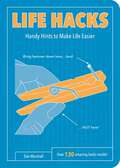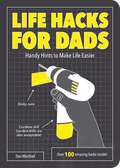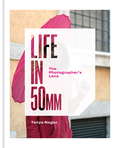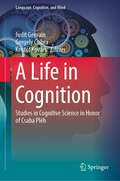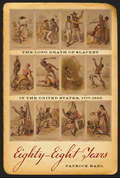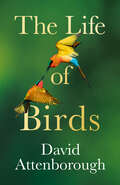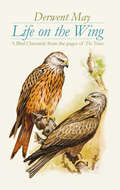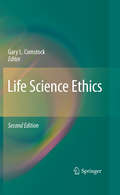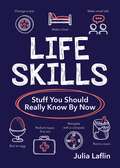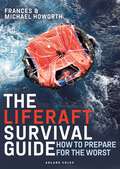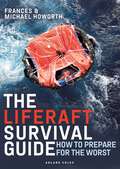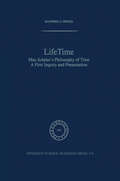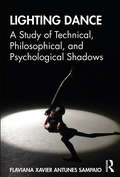- Table View
- List View
The Life Cycles of Butterflies: From Egg to Maturity, a Visual Guide to 23 Common Garden Butterflies
by Judy Burris Wayne RichardsThis stunning photographic guide will have butterfly enthusiasts of all ages aflutter. Judy Burris and Wayne Richards include more than 400 full-color, up-close images that present the life cycles of 23 common North American butterflies in amazing detail. Watch caterpillars hatch from eggs, eat and grow, form into chrysalides, emerge as colorful butterflies, and fly through the air. You&’ll also learn which plants butterflies avoid and which native species they&’re attracted to, so you can create your own backyard butterfly haven.
Life Energies, Forces and the Shaping of Life: Book I (Analecta Husserliana #74)
by Anna-Teresa TymienieckaThe nature of life consists in a constructive becoming (see Analecta Husserliana vol. 70). Though caught up in its relatively stable, stationary intervals manifesting the steps of its accomplishments that our attention is fixed. In this selection of studies we proceed, in contrast, to envisage life in the Aristotelian perspective in which energia, forces, and dynamisms of life at work are at the fore. Startling questions emerge: `what distinction could be drawn between the prompting forces of life and its formation? Or, is this distinction a result of our transcendental faculties?' The answers to these questions reveal themselves, as Tymieniecka proposes, at the phenomenologically ontopoietic level of life's origination where transcendentality surges.
Life Hacks: Handy Tips to Make Life Easier (Life Hacks Ser.)
by Dan MarshallEver accidentally used your thumb as a hammer cushion while putting up a picture hook? Dozens of everyday dilemmas are solved with Life Hacks. This fully illustrated manual covers everything from nifty electric cable management to ingenious cooking methods and much, much more.
Life Hacks for Dads: Handy Hints to Make Life Easier (Life Hacks Ser.)
by Dan MarshallLife Hacks for Dads is your handy guide to making your daily life that little bit easier. This fully illustrated manual covers everything from keeping your car door wonderfully dent-free to making sure your kids stay entertained, and much, much more.
Life in 50mm: The Photographer's Lens
by Tanya NagarThe 50mm lens is for photography purists. It's cheap to buy, light to carry and gets amazing results. It also makes even the greatest photographers try just that little bit harder to frame the perfect image. As a result, it's the first thing anyone buys after their camera. Life in 50mm shares the greatest photos - and the personal experiences that led to them - from some of today's leading photographers. It also explains why they chose to reject complicated modern zooms and express themselves through the 50mm prime in the first place.
A Life in Cognition: Studies in Cognitive Science in Honor of Csaba Pléh (Language, Cognition, and Mind #11)
by Judit Gervain Gergely Csibra Kristóf KovácsThis edited book offers a broad selection of interdisciplinary studies within cognitive science. The book illustrates and documents how cognitive science offers a unifying framework for the interaction of fields of study focusing on the human mind from linguistics and philosophy to psychology and the history of science. A selection of renowned contributors provides authoritative historical, theoretical and empirical perspectives on more than six decades of research with a special focus on the progress of cognitive science in Central Europe. Readers encounter a bird’s eye view of geographical and linguistic diversity brought about by the cognitive revolution, as it is reflected in the writings of leading authors, many of whom are former students and collaborators of Csaba Pléh, a key figure of the cognitive turn in Central Europe, to whom this book is dedicated. The book appeals to students and researchers looking for the ways various approaches to the mind and the brain intersect.
Life in the Glory of Its Radiating Manifestations: 25th Anniversary Publication Book I (Analecta Husserliana #48)
by Anna-TeresaTymienieckaWestern thought is surging, on the rebound from centuries of a merely background interest. Life is presenting crucial challenges to the human mind in science, technology, culture and social existence; challenges which reach the core of existence, human destiny, and the very meaningfulness - the human significance of life itself. The compartementalized sciences fall short of responding to this challenge, and present day philosophy by and large renounced its vocation of carrying the torch of reason. In this post-modern darkness, the Phenomenology of Life and of the Human Condition excavate and bring to light the Logos of Life in its entire harmonizing interplay. In the present collection, which continues the long and winding itinerary of our previous probings, we first uncover the new field of the ontopoiesis of life by means of the self-individualisation of life, the key to its labyrinth (Tymieniecka). A network of the ontopoietic itineraries manifest life in its innumerable perspectives: the constructive scanning (chronos and Kairos) are treated specifically by Eva Syristova, M. Bielawka, F. Bosio, and M.A. Cecilia. Individualising dynamisms of passions and the tying of the communal order by G. Bucher, R. Sweeney, A. Polis, A. Zvie Bar-On and others. The life-struggle for the light of the spirit by L. Sundararajan, I.R. Owen etc. The deep springs of mundaneity in human existence (moral sense, empathy, communication) by A. Luse, A. Ales Bello, J. Cibulka, J. Sivak, etc. The life of the spirit (historicity) by M. Sancipriano, M. Cekic, H. Rodríguez Piñeiro, S. Rinofner-Kreidl and others.
Life is Limited..Live Unlimited: Improvisation And The Theatre (Bloomsbury Revelations Ser.)
by Mr Sanjiva DubeyLife is Limited.. Live Unlimited recounts a fascinating personal transformational journey. This book is a rich blend of modern thinking and technology usage, drawing heavily from age old Indian scriptures to arrive at the transformational prescriptions which are simple to understand and easy to adopt. This book is for all new age individuals, professionals, students, home makers, business persons who wish to strike the right work life balance and be happy and satisfied without sacrificing their career goals. Using the tips, tools and techniques from this book they can achieve the unlimited potential of life in a limited time span, apart from enjoying the anecdotes, shlokas and teachings from gurus.
The Life of a Song Volume 2: The Stories Behind 50 More of the World’s Best-loved Songs
by David Cheal Jan DalleyWhen great songs have been written and released, they often take on a life of their own, reshaped and given new life, transcending genres.THE LIFE OF A SONG is a compilation of weekly columns written for FT Weekend, containing the biographies of 50 songs that have been born, reborn, sometimes hideously mangled, but often reinvigorated by new generations of artists.Here you will find songs that shook the world, songs that heralded the birth of a new musical movement, songs that made the journey from soul to punk and from heavy rock to hip-hop.
The Life of Birds
by David AttenboroughA fully updated new edition of David Attenborough’s bestselling classic.
Life on the Wing: A Bird Chronicle from the pages of The Times
by Derwent MayFrom dainty avocets prancing along the seashore to panic-stricken waxwings frenziedly gobbling berries, from barking barnacle geese to soaring skylarks, Derwent May writes about birds in a very special way. As he goes in search of birdlife in a variety of places - the English lanes and rolling corn fields that he loves, the lonely Essex marshes, the remote bird-haunted islands of Grassholm and Fair Isle - May reveals just what it feels like to be a birdwatcher. With him, the reader will experience the excitement of fresh discoveries, the peace and contentment that birds can bring and the comedy to be found both in the behaviour of birds and the human response to them. May is an alert observer of avian habits and manners, describing them vividly and poetically, but underlying everything he writes is scientific knowledge and a wealth of experience. Employing all of these skills and drawing on his popular weekly 'Feather Reports' column from The Times, May creates a fascinating chronicle of a year in the life of our birds, from robins to rarities, with Peter Brown's illustrations adding the perfect finishing touch.
Life, Organisms, and Human Nature: New Perspectives on Classical German Philosophy (Studies in German Idealism #22)
by Luca Corti Johannes-Georg SchüleinThis collection of essays investigates the notions of life, living organisms, and human nature in Classical German Philosophy from a historical and conceptual perspective. Its 19 chapters move from the peculiarities of organic life to the peculiarities of the distinctly human life form and discuss the strengths and weaknesses of naturalistic accounts of life. In light of the growing interest in nature within current philosophical debates, the book provides an overview of what the philosophical epoch of Kant, Fichte, Schelling, Humboldt, the Romantics, Hegel, and others can contribute to our understanding of life today. The collection of essays represents a plurality of approaches that reflects the pluralism of the tradition itself – highlighting the liveliness and polyphonic nature of the issues at stake and the ways in which they were approached in post-Kantian thought.In combining historical and philosophical investigation, the collection constitutes a unique resource for scholars and graduate students working in various areas related to the study of nature in philosophy, contemporary theories of science, and the humanities more generally.
Life - The Outburst of Life in the Human Sphere: Scientific Philosophy / Phenomenology of Life and the Sciences of Life. Book II (Analecta Husserliana #60)
by Anna-Teresa TymienieckaScience and philosophy have both undergone radical transformations in recent times. Now they are poised for a pivotal alliance. Science has abandoned the mechanistic model of nature. Philosophy has broken through the tight, traditional circle of conceptualisation, intellectualistic preconceptions and cognitive presuppositions. The two now meet to focus on the palpitating, fluctuating stream of nature/life. Their traditional prejudices dispersed under the pressure of new evidence, philosophy/phenomenology of life and the sciences of life meet in the Archimedean point of the human creative condition (proper to the phenomenology of life) and the role of the human subject (central to the scientific view of reality). They necessitate each other: without the sciences of life, philosophy/phenomenology of life cannot penetrate the intricacies of nature/life; without recourse to philosophy to delineate, design, provide clues to the organisation of natural evidence, the sciences of life cannot devise new strategies for inquiry nor survey their field. The present collection throws open the barriers that separate nature and culture, works of physis and those of the spirit. Following the philosophical model of the ontopoieisis of life, focusing on its specifically human sphere - that of the human self-interpretation-in-existence - it encircles the vast, new horizons of the new alliance.
Life Phenomenology of Life as the Starting Point of Philosophy: 25th Anniversary Publication Book III (Analecta Husserliana #50)
by Anna-Teresa TymienieckaThis collection presents perspectives into the pristine field of phenomenology/philosophy of life conceived by Tymieniecka, initiated in the Analecta Husserliana and unfolding with each volume. This new and original philosophy reaches to the `inner workings of Nature' as well as to the innermost recesses of the Human Creative Condition, opening a basic starting point for all philosophy. Life, `the theme of our times', finds at last a profound philosophical treatment.
Life Science Ethics
by Gary L. ComstockDoes nature have intrinsic value? Should we be doing more to save wilderness and ocean ecosystems? What are our duties to future generations of humans? Do animals have rights? This revised edition of "Life Science Ethics" introduces these questions using narrative case studies on genetically modified foods, use of animals in research, nanotechnology, and global climate change, and then explores them in detail using essays written by nationally-recognized experts in the ethics field. Part I introduces ethics, the relationship of religion to ethics, how we assess ethical arguments, and a method ethicists use to reason about ethical theories. Part II demonstrates the relevance of ethical reasoning to the environment, land, farms, food, biotechnology, genetically modified foods, animals in agriculture and research, climate change, and nanotechnology. Part III presents case studies for the topics found in Part II.
Life Scientific Philosophy, Phenomenology of Life and the Sciences of Life: Ontopoiesis of Life and the Human Creative Condition (Analecta Husserliana #59)
by Anna-Teresa TymienieckaThis collection brings to the public the fruits of the groundlaying work on the philosophy/phenomenology of life presented in some 30 volumes of the Analecta Husserliana, and inaugurates a new phase in philosophy/phenomenology - a truly radical turn. As Tymieniecka in her introduction puts it, the time is ripe to abandon the prejudices against empiria and set aside in a `second position' the epistemological/constitutive criterion of validity and truth - without, however, abandoning it. To the contrary: recognising with our present culture the overwhelmingly superior validity of the pragmaticity test, which science indubitably applies in its `verification' of technology, philosophy/phenomenology at last reaches the full significance of reality: the fullness of the vital fact of life, which comprises not only the works and enjoyment of the mind and the spirit, but those of the bios and the cosmos too. The full-fledged dialogue with the hard-core sciences opens up; philosophy of life and the human creative condition draws together all the radiations of life into its field of inquiry. Tymieniecka thus proposes a new mathesis universalis - the dream of Leibniz and Husserl - which can at least be fulfilled.
Life Skills: Stuff You Should Really Know By Now
by Julia LaflinFull of useful advice and practical skills that everyone should know, this book will provide you with the essential knowledge you need to tackle life’s everyday challenges. From how to boil an egg to speaking in public, this handy guide will arm you with all the skills you need to navigate life in the real world like a pro.
Lifelong Education and the Training of Teachers: Developing a Curriculum for Teacher Education on the Basis of the Principles of Lifelong Education
by A.J. Cropley R.H. DaveLifelong Education and the Training of Teachers: Developing a Curriculum for Teacher Education on the Basis of the Principles of Lifelong Education focuses on the role of teachers and their training relative to educational changes. The selection particularly explains the influence of teachers on the delivery of educational services and on the personal, social, and productive lives of their pupils. The book first discusses the defects in traditional education, practicability of lifelong education, and the relationship of lifelong education and the school. The manuscript also takes a look at lifelong education and training of teachers, including roles and responsibilities of teachers, implications for teacher training curriculum, concepts in teacher education, and implications for teaching practice. The text focuses on changes in theory courses and practice teaching, as well as teaching and learning processes, content of the changes, fostering educability, and broadened concept of practice teaching. The manuscript also reviews the changes in the institutions. Concerns include need for institutional changes, organizational changes, and relationship with other institutions. The book is a vital reference for readers interested in the education and training of teachers.
The Liferaft Survival Guide: How to Prepare for the Worst
by Michael Howorth Frances HoworthThis is the ultimate guide to liferaft survival for all boaters and its purpose is to ensure the survival of skipper and crew in the event of their boat sinking. In this essential safety book, expert authors, Frances and Michael Howorth, cover how to be mentally and physically prepared for a sailor's ultimate nightmare. It includes invaluable advice on the essentials to pack into the emergency grab bag for a short or long cruise, hot or cold climate, coastal or offshore trip. Packed full of checklists and clear diagrams, there are lessons learned from disasters, flowcharts to prioritise abandon ship procedure, sections on first aid and emergency treatment. Featuring some essential content from the authors' previous title The Grab Bag Book but completely revised and updated, the new Liferaft Survival Guide is what you need right now to stay safe at sea and covers up to date information on the way satellites and beacons work, world monitoring of distress signals and advances in medical practice. Preparation and planning are key for safe enjoyable sailing. Every boater needs to plan and prepare, and every boater should read this book. This unique survival at sea handbook helps you ensure your crew's survival in a liferaft. Buy it, build your own grab bag and be sure to be prepared!
The Liferaft Survival Guide: How to Prepare for the Worst
by Michael Howorth Frances HoworthThis is the ultimate guide to liferaft survival for all boaters and its purpose is to ensure the survival of skipper and crew in the event of their boat sinking. In this essential safety book, expert authors, Frances and Michael Howorth, cover how to be mentally and physically prepared for a sailor's ultimate nightmare. It includes invaluable advice on the essentials to pack into the emergency grab bag for a short or long cruise, hot or cold climate, coastal or offshore trip. Packed full of checklists and clear diagrams, there are lessons learned from disasters, flowcharts to prioritise abandon ship procedure, sections on first aid and emergency treatment. Featuring some essential content from the authors' previous title The Grab Bag Book but completely revised and updated, the new Liferaft Survival Guide is what you need right now to stay safe at sea and covers up to date information on the way satellites and beacons work, world monitoring of distress signals and advances in medical practice. Preparation and planning are key for safe enjoyable sailing. Every boater needs to plan and prepare, and every boater should read this book. This unique survival at sea handbook helps you ensure your crew's survival in a liferaft. Buy it, build your own grab bag and be sure to be prepared!
Lifetime: Max Scheler’s Philosophy of Time (Phaenomenologica #169)
by M.S. FringsUsing posthumous manuscripts, the author shows that Scheler conceived the origin of time in the self-activating center of individual and universal life as threefold ‘absolute’ time of a four-dimensional expanse. This serves as a basis for establishing the phenomenon of objective time in multiple steps of constitutionality, including the physical field theory and theory of relativity.
A Lifetime of Seasons: The Best of Christopher Lloyd
by Christopher Lloyd'He was the best informed, liveliest and most innovative gardening writer of our times' GUARDIAN'Infuriating, irascible ... a brilliant gardener and a brilliant writer' Monty Don, ObserverChristo Lloyd was recognised as one of the foremost gardeners and garden writers of the 20th century. Here, for the first time, is the definitive collection of his best, most informative, and so often amusing, garden writing.Christo on gardening: Ours, in its humble way, is an art as well as a craft. At the same time it keeps us in touch with the earth, the seasons, and with that complex of interrelated forces both animate and inanimate which we call nature. It is a humanizing occupation.On weeding: Many gardeners will agree that hand-weeding is not the terrible drudgery that it is often made out to be. Some people find in it a kind of soothing monotony. It leaves their minds free to develop the plot for their next novel or to perfect the brilliant repartee with which they should have encountered a relative's latest example of unreasonableness.
Lighting Dance: A Study of Technical, Philosophical, and Psychological Shadows
by Flaviana Xavier SampaioLighting Dance pioneers the discussion of the ability of lighting design to foreground shadow in dance performances. Through a series of experiments integrating light, shadow, and improvised dance movement, it highlights and analyses what it advances as an innovative expression of shadow in dance as an alternative to more conventional approaches to lighting design. Different art forms, such as painting, film, and dance pieces from Loie Fuller, the Russell Maliphant Dance Company, Elevenplay, Pilobolus, and the Tao Dance Theater served to inspire and contextualise the study. From lighting to psychology, from reviews to academic books, shadows are examined as a symbolic and manipulative entity. The book also presents the dance solo Sombreiro, which was created to echo the experiments with light, shadow, and movement aligned to an interpretation of cultural shadow (Jung 1954, in Samuels, Shorter, and Plaut 1986; Casement 2006; Ramos 2004; Stein 2004; and others). The historical development of lighting within dance practices is also outlined, providing a valuable resource for lighting designers, dance practitioners, and theatre goers interested in the visuality of dance performances.
Lighting Dance: A Study of Technical, Philosophical, and Psychological Shadows
by Flaviana Xavier SampaioLighting Dance pioneers the discussion of the ability of lighting design to foreground shadow in dance performances. Through a series of experiments integrating light, shadow, and improvised dance movement, it highlights and analyses what it advances as an innovative expression of shadow in dance as an alternative to more conventional approaches to lighting design. Different art forms, such as painting, film, and dance pieces from Loie Fuller, the Russell Maliphant Dance Company, Elevenplay, Pilobolus, and the Tao Dance Theater served to inspire and contextualise the study. From lighting to psychology, from reviews to academic books, shadows are examined as a symbolic and manipulative entity. The book also presents the dance solo Sombreiro, which was created to echo the experiments with light, shadow, and movement aligned to an interpretation of cultural shadow (Jung 1954, in Samuels, Shorter, and Plaut 1986; Casement 2006; Ramos 2004; Stein 2004; and others). The historical development of lighting within dance practices is also outlined, providing a valuable resource for lighting designers, dance practitioners, and theatre goers interested in the visuality of dance performances.


